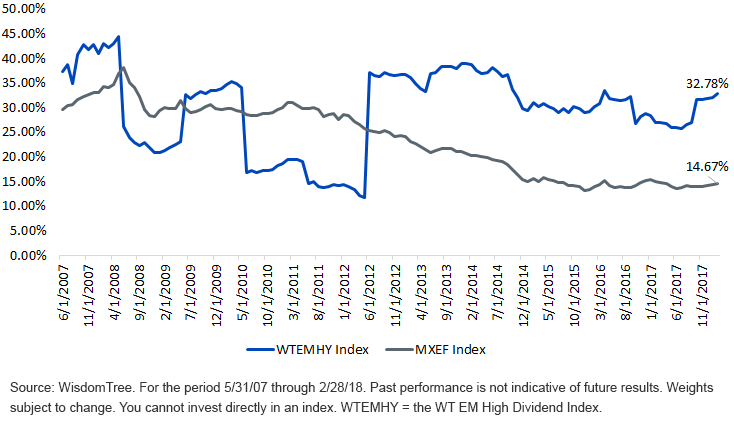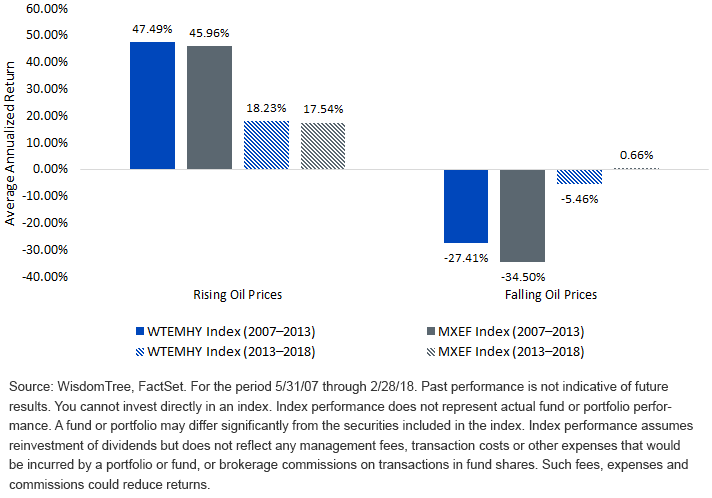How Oil Prices Impact the Emerging Markets


Oil prices experienced a brutal decline that lasted 18 months from the summer of 2014 through early 2016, during which time the price of oil fell more than 75% from its peak.1 But recently, oil has shown signs of buoyancy. We’ve previously talked about how to take advantage of improving oil and commodity conditions; however, we believe that outside of direct commodity exposure, oil prices tend to coincide with robust emerging market (EM) equity prices. In particular, we believe the WisdomTree Emerging Markets High Dividend Index (WT EM High Dividend Index) is particularly well positioned for rising oil and commodity prices. Here’s why:
The WT EM High Dividend Index was launched in 2007 to track the performance of the highest-dividend-paying companies in the region. The Index weights companies that rank in the highest 30% by dividend yield using annual cash dividends paid. Since its inception more than 10 years ago, the WT EM High Dividend Index has outperformed its benchmark, the MSCI Emerging Markets Index (MXEF), by 151 basis points (bps) annually—raising the question about whether an investor really needs an active manager to outperform in this “inefficient” asset class.
However, like many of the more successful active strategies, there can be long periods during which the investment style and discipline are out of favor—that would be the case over the last three to five years.
Contrasting Sector Exposures in EM High Dividend vs. Cap-Weighted Beta
Oil prices peaked in 2008 at around $145 a barrel. At the time, the energy and materials sectors were 35% of the weight in the cap-weighted MSCI Emerging Markets Index, and going into 2008, the WT EM High Dividend Index was actually over-weight those sectors. However, as prices rose, the WT EM High Dividend Index reduced weight dramatically, and from 2009 to 2012, it was under-weight the MSCI EM Index in commodity sectors.
As oil prices and commodities continued out of favor and MXEF added more technology companies from China, commodity sectors saw ever-decreasing weight and currently represent less than 15% of the cap-weighted Index. However, due to new government dividend policies in select EM countries, energy and materials companies began paying larger dividends and thus became eligible for inclusion in the WT EM High Dividend Index.
Now, there is more than twice as much weight in the WT EM High Dividend Index compared to the cap-weighted MSCI EM Index.
Combined Weight in Energy and Material Sectors

This sector exposure change may naturally lead observers to think that, compared to the MSCI EM Index, the performance of the WT EM High Dividend Index was more sensitive to oil prices in the last five years than it was in its first five years. And that, in fact, did play out.
The return attribution below breaks down returns over rising oil price periods and falling oil price periods: The solid bars below show returns for the first five and a half years of the WT EM High Dividend Index’s existence, while the textured bars show returns for the most recent five-year period as of February 28, 2018.
If we look at how both the WT EM High Dividend Index and the MSCI EM Index fared during periods of rising and falling oil prices,2 we see very robust returns for emerging markets generally during rising oil prices and very subdued or negative returns during falling oil price environments. In the 2007–2013 period, both Indexes averaged gains of more than 45% during rising oil prices and suffered losses greater than 27% during falling prices. In the first five years, the WisdomTree Index actually was more defensive during falling oil prices, and weight to commodity sectors was cut at the 2008 rebalance due to high prices and low dividend yields.
During the second period of analysis, from 2013 to 2018, the oil price sensitivity of both Indexes decreased—and gains were a bit more muted during rising oil prices and losses not as severe during falling oil prices. In fact, the MSCI EM Index was able to squeeze out a slightly positive return during falling oil prices, although the more energy-heavy WT EM High Dividend Index still faced losses during the 2013–2018 period.
Returns When Oil Prices Rise or Fall

A number of potential geopolitical situations could affect the price of oil this year. Heightened probability of conflict between Saudi Arabia and Iran, a potential U.S. withdrawal from the Iran nuclear deal and a decrease in Venezuelan crude output are only a few.
If commodity prices stay robust and have further gains in 2018, exposure to WisdomTree’s Emerging Markets High Dividend ETF (DEM), which tracks WTEMHY, could be a good fit in your portfolio, and we are seeing relatively strong results thus far in 2018. Visit the DEM page for standardized performance.
1Source: FactSet.
2Defined by the trend of their 22-day moving average.
Important Risks Related to this Article
There are risks associated with investing, including possible loss of principal. Foreign investing involves special risks, such as risk of loss from currency fluctuation or political or economic uncertainty. Funds focusing on a single sector generally experience greater price volatility. Investments in emerging, offshore or frontier markets are generally less liquid and less efficient than investments in developed markets and are subject to additional risks, such as risks of adverse governmental regulation and intervention or political developments. Due to the investment strategy of this Fund, it may make higher capital gain distributions than other ETFs. Please read the Fund’s prospectus for specific details regarding the Fund’s risk profile. Investments in commodities may be affected by overall market movements, changes in interest rates and other factors such as weather, disease, embargoes and international economic and political developments.
The Global Industry Classification Standard (“GICS”) was developed by and is the exclusive property and a service mark of MSCI Inc. (“MSCI”) and Standard & Poor’s (“S&P”), a division of The McGraw-Hill Companies, Inc., and is licensed for use by WisdomTree Investments, Inc. Neither MSCI, S&P nor any other party involved in making or compiling the GICS or any GICS classifications makes any express or implied warranties or representations with respect to such standard or classification (or the results to be obtained by the use thereof), and all such parties hereby expressly disclaim all warranties of originality, accuracy, completeness, merchantability and fitness for a particular purpose with respect to any such standard or classification. Without limiting any of the foregoing, in no event shall MSCI, S&P, any of their affiliates or any third party involved in making or compiling the GICS or any GICS classifications have any liability for any direct, indirect, special, punitive, consequential or any other damages (including lost profits), even if notified of the possibility of such damages.

Alejandro Saltiel joined WisdomTree in May 2017 as part of the Quantitative Research team. Alejandro oversees the firm’s Equity indexes and actively managed ETFs. He is also involved in the design and analysis of new and existing strategies. Alejandro leads the quantitative analysis efforts across equities and alternatives and contributes to the firm’s website tools and model portfolio infrastructure. Prior to joining WisdomTree, Alejandro worked at HSBC Asset Management’s Mexico City office as Portfolio Manager for multi-asset mutual funds. Alejandro received his Master’s in Financial Engineering degree from Columbia University in 2017 and a Bachelor’s in Engineering degree from the Instituto Tecnológico Autónomo de México (ITAM) in 2010. He is a holder of the Chartered Financial Analyst designation.

